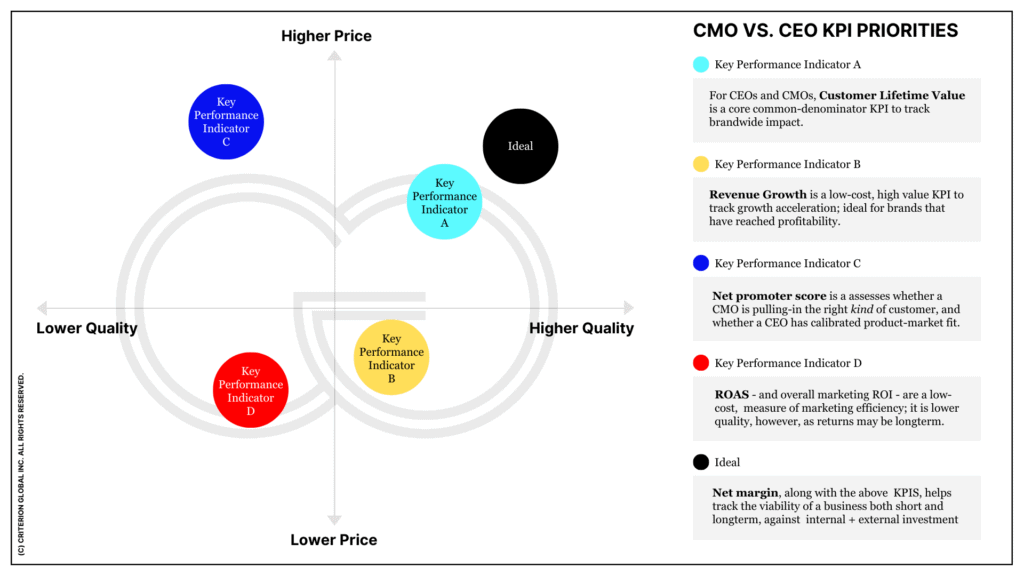To ensure success, CMOs must track specific metrics that reflect the effectiveness of their marketing campaigns. These metrics, known as Key Performance Indicators (KPIs), provide important insights into the performance of the marketing team, helping to make informed decisions and adjust strategies as needed. But the priorities of a CMO can differ greatly from that of a CEO. Here’s how to bridge the gap within your organization.
Table of Contents: CMO vs. CEO KPIs
What are CMO key performance indicators?
CMO KPIs typically vary depending on the business goals and objectives, but some of the most common ones include customer acquisition cost (CAC), customer lifetime value (CLTV), website traffic, conversion rates, lead generation, and brand awareness.
CAC measures the cost of acquiring a new customer, while CLTV measures the total revenue that a customer will generate over their lifetime. These two metrics are crucial for determining the return on investment (ROI) of marketing campaigns and optimizing budget allocation.
Website traffic and conversion rates are also key metrics for CMOs to monitor, as they provide insights into the effectiveness of a company’s digital marketing efforts. Lead generation and brand awareness are also important metrics to track, as they reflect the success of marketing efforts in creating new business opportunities and establishing the company’s reputation in the market.
What are CEO key performance indicators?
The CEO of a company has the ultimate responsibility for the success of the organization. In order to achieve this success, it is essential for the CEO to set clear goals and expectations for the company’s performance.
CEOs typically focus on a few key areas when setting KPIs. These may include financial performance, customer satisfaction, employee engagement, innovation, and sustainability. For example, a CEO may set a KPI for revenue growth or profitability, as these are key measures of financial success. Additionally, customer satisfaction may be measured through metrics such as Net Promoter Score or customer retention rate, while employee engagement may be measured through metrics such as turnover rate or employee satisfaction surveys.
One of the main reasons KPIs are important for CEOs is that they provide a clear framework for measuring progress toward strategic goals. By setting specific KPIs and tracking them over time, CEOs can assess the success of their strategies and make adjustments as needed. KPIs also help CEOs prioritize their efforts and allocate resources to areas of the business that are most critical to achieving the company’s goals.
In addition to providing a framework for measuring progress, KPIs also help CEOs communicate with stakeholders, such as investors, board members, and employees. By sharing KPIs and progress towards strategic goals, CEOs can build trust and confidence among these stakeholders, which is essential for maintaining support for the company’s vision and strategy.
Overall, KPIs are a critical tool for CEOs to set and achieve strategic goals, measure progress, and communicate with stakeholders. By focusing on key areas of the business and setting specific metrics to track progress, CEOs can ensure that the company is moving in the right direction and achieving success.
Are CMO and CEO KPIs different?
CEOs are responsible for the overall success of the company and their KPIs typically focus on financial performance, revenue growth, profitability, and shareholder value. Examples of CEO KPIs include revenue, profit margin, return on investment, market share, and customer satisfaction.
On the other hand, CMOs are responsible for the marketing strategies and campaigns that drive revenue and brand awareness for the company. Their KPIs may focus on metrics such as lead generation, conversion rates, customer acquisition, customer retention, and brand recognition.
While some KPIs may overlap between CEOs and CMOs, their respective focuses are different, and the KPIs they use to measure success should reflect that. Overall, the KPIs for both roles should be aligned with the company’s overall goals and objectives.

CMO vs. CEO KPIs: Finding Common Ground
As the lifespan of CMOs becomes shorter, they must find compelling ways to communicate the value of their work in ensuring business growth. Criterion Global offers a variety of deliverables designed to support CMOs in justifying and championing marketing investment, and proving the effectiveness against business outcomes. Not just so-called “vanity” KPIs so common in marketing.
Contact us to learn how to empower your marketing efforts with CEO-favored measurement – backed by data – to prove the effectiveness of your work.